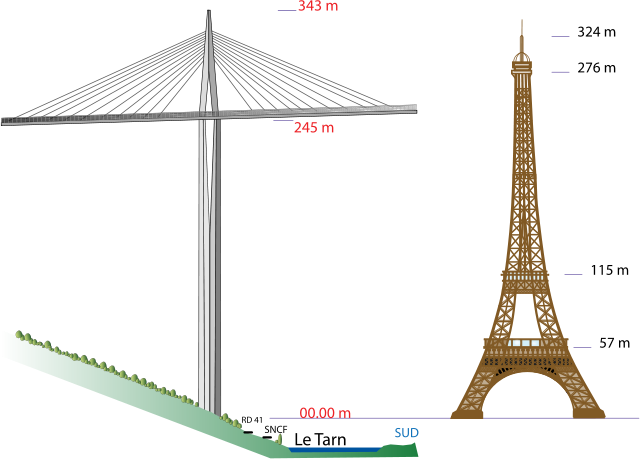 |
This is a file from the Wikimedia Commons. Information from its description page there is shown below.
Commons is a freely licensed media file repository. You can help.
|
Summary
|
Camera location
|
44° 4′ 58.99″ N, 3° 1′ 25.58″ E
|
This and other images at their locations on: Google Maps - Google Earth - OpenStreetMap |
( Info)44.083053888889;3.0237719444444 |
| Description |
Français : Elévation comparative de la pile P2 du viaduc de Millau (France), la plus haute pile de pont au monde, avec la Tour Eiffel (Paris).
English: height diagram comparing the highest Pier (P2) of the Millau Viaduct in France with the Eiffel Tower
Deutsch: Höhenvergleich zwischen dem höchsten Brückenpfeiler (P2) des Viaduc de Millau (Frankreich), dem höchsten Brückenpfeiler der Welt, mit dem Eiffelturm (Paris).
|
| Date |
26 February 2009 |
| Source |
self-made from a schema in "Le viaduc de Millau-Midi Libre-Centre Presse - juin 2004" and photos |
| Author |
Roulex_45 |
Licensing
I, the copyright holder of this work, hereby publish it under the following licenses:
 |
Permission is granted to copy, distribute and/or modify this document under the terms of the GNU Free Documentation License, Version 1.2 or any later version published by the Free Software Foundation; with no Invariant Sections, no Front-Cover Texts, and no Back-Cover Texts. A copy of the license is included in the section entitled GNU Free Documentation License. http://www.gnu.org/copyleft/fdl.htmlGFDLGNU Free Documentation Licensetruetrue
|
You may select the license of your choice.
|
File usage
The following pages on Schools Wikipedia link to this image (list may be incomplete):
This file contains additional information, probably added from the digital camera or scanner used to create or digitize it. If the file has been modified from its original state, some details may not fully reflect the modified file.
All five editions of Schools Wikipedia were compiled by SOS Childrens Villages. SOS Children believes education is an important part of a child's life. That's why we ensure they receive nursery care as well as high-quality primary and secondary education. When they leave school, we support the children in our care as they progress to vocational training or higher education. You can help by sponsoring a child.



